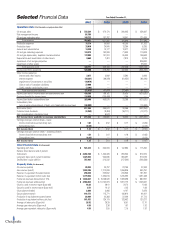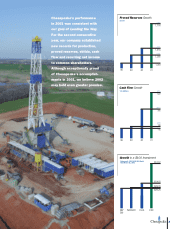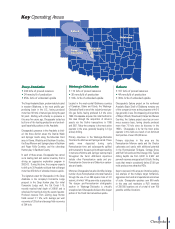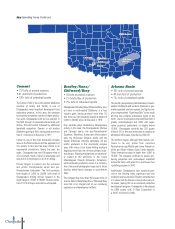Chesapeake Energy 2001 Annual Report Download - page 8
Download and view the complete annual report
Please find page 8 of the 2001 Chesapeake Energy annual report below. You can navigate through the pages in the report by either clicking on the pages listed below, or by using the keyword search tool below to find specific information within the annual report.
Key Operating Areas Continued
Cement
•137 bcfe of proved reserves
•41 mmcfe/d of production
•100+ bcfe of unbooked upside
The Cement field in the south-central Oklahoma
counties of Grady and Caddo is one of
Chesapeake’s most important development and
exploratory projects. In this area, the company
has recently completed a series of highly produc-
tive wells. Chesapeake built its core position in
this field through its corporate transactions with
AnSon, DLB and Gothic followed by additional
leasehold acquisition. Cement is yet another
Oklahoma giant gas field, having produced more
than 2.1 tcfe since its discovery in 1917.
Cement is one of the most structurally complex
areas in the Mid-Continent and the application of
3-D seismic to this area has been critical to its
rejuvenated productivity during the past ten
years. Chesapeake has over 180 square miles of
3-D in Cement, much of which is proprietary, and
uses this 3-D information in all of its drilling.
Primary targets in Cement are the numerous
and prolific Pennsylvanian sands and pre-
Pennsylvanian carbonates. The field produces
from depths of 2,000’ to 20,000’ with most of
Chesapeake’s drilling activity focused in the
depth range of 12,500’ to 18,000’. Reserve poten-
tial of 10-15 bcfe per well can be anticipated.
Bradley/Knox/
Chitwood/Bray
•16 bcfe of proved reserves
•21 mmcfe/day of production
•75+ bcfe of unbooked upside
Chesapeake’s Bradley/Knox/Chitwood/Bray proj-
ect area in south-central Oklahoma is a true
industry giant, having produced more than 3.5
tcfe from over 20 formations located at depths of
2,000’ to 20,000’ since its discovery in 1918.
Four separate plays characterize Chesapeake’s
activity in this area: the Pennsylvanian Morrow
and Springer sands, the pre-Pennsylvanian
Sycamore, Woodford, Hunton and Viola carbon-
ates, the Ordovician Simpson sands, and the
deeper Ordovician Arbuckle carbonate. All are
prolific producers in this structurally complex
area, with many of our future drilling locations
targeting more than one of these primary objec-
tive groups. Trapping mechanisms are structural-
ly related to the anticlines in the Lower
Mississippian through Ordovician formations,
while shallower production occurs in a combina-
tion of structural-stratigraphic traps due to thrust
faulting, lateral facies changes or unconformity
traps.
The company has more than 350 square miles of
seismic data in the Bradley/Knox/ Chitwood/Bray
area that is an integral part of our continuing
exploration and development efforts.
Arkoma Basin
•161 bcfe of proved reserves
•40 mmcfe/d of production
•75+ bcfe of unbooked upside
The prolific gas-producing Arkoma Basin of south-
eastern Oklahoma and western Arkansas is gen-
erally separated into two regions, the highly com-
plex compressional “Overthrust Belt” to the south
and the less complex extensional region to the
north. Due to its complexity, the Overthrust Belt is
greatly underdeveloped and holds vast explo-
ration potential, particularly at depths below
12,000’. Chesapeake currently has 225 square
miles of 3-D in this area with plans to acquire an
additional 300 square miles during 2002-03.
The northern region, although more mature, con-
tinues to be very active from numerous
Pennsylvanian age Middle and Lower Atokan tur-
bidite and Basal Atokan (Spiro) delta deposits.
These formations range in depth from 5,000’ to
15,000’. The company continues to acquire pro-
ducing properties and undeveloped leasehold
across the basin with plans for a continuous two
rig drilling program in 2002.
Additionally, Chesapeake’s vast leasehold posi-
tion in the Arkoma holds significant coal bed
methane reserve potential. Pipeline infrastructure
is in place and the Arkoma coals produce very lit-
tle water, making this an economically attractive
development program. Chesapeake is developing
its CBM assets with El Paso Corporation in
a 33/67 JV formed in 2000.
Arkoma
Basin
Arkoma
Basin
Cement
Cement
6
Knox
Knox
Bradley
Bradley
Chitwood
Chitwood
Bray
Bray
Oklahoma
Oklahoma













